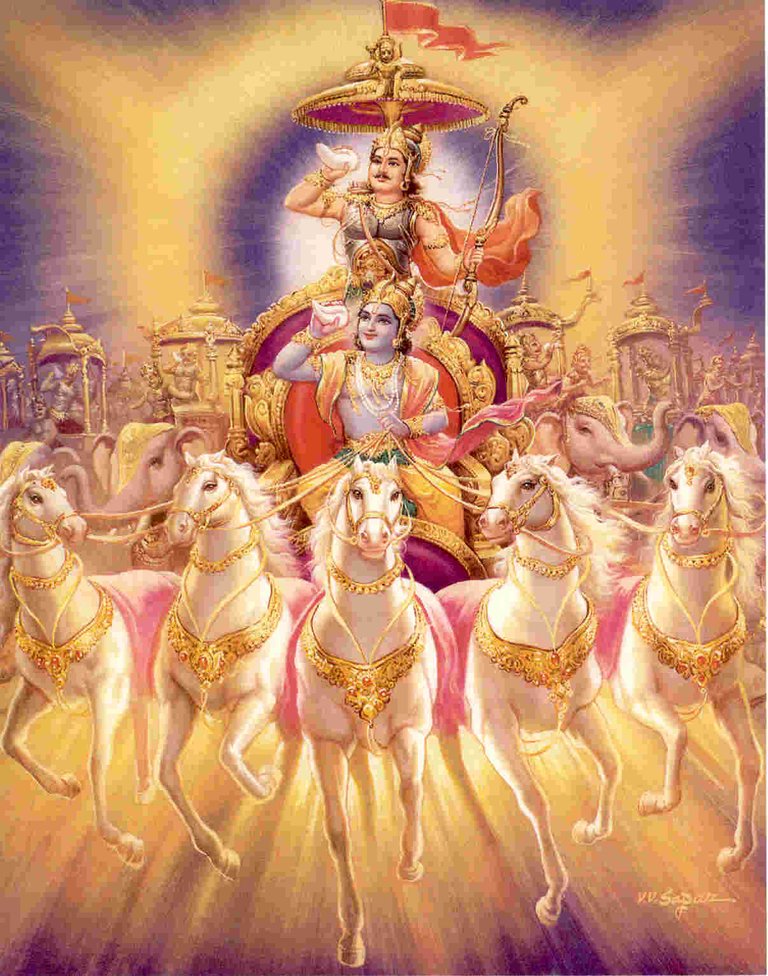Know thyself is not only an ancient Greek aphorism. It is also the first verse of the Vedanta Sutra.
Athato brahma jijnasa – Therefore, now we should inquire into brahman (spirit)
What does it mean to be self-realized? The symptoms, to answer that question, are stated in chapter two of Bhagavad Gita. Someone who is established in the self, is transcendental to the material influences of life, known as the three modes of nature, namely goodness (sattva), passion (rajas) and ignorance (tamas).

Also, they are free from all dualities. And they are free from anxieties. Another name for the kingdom of god, or the spiritual world is Vaikuntha, which literally means “free from anxieties”. That’s the place where we belong ultimately. This place, on the other hand, is full of anxieties.
Except for the person who is self-realized. Even the anxiety for gain and safety falls away when one is self-realized, and sees the self as eternal. Then not only mating, sleeping and eating are spontaneously reduced, but also defending becomes unimportant to the seer of the self. These anxieties fall away because the influence of the modes of nature have fallen away.
One becomes not only situated in the mode of goodness (sattva), but enters the zone of transcendental purity of consciousness (suddha sattava). This is like being in the liberated state while still in the body. This is a rare state of being, perhaps only glimpsed by a few icons of society who manage to achieve the patience and determination to achieve such a state.
We can all aspire to attain liberation, by acquiring the knowledge of how and by having a mentor to assist, if possible. If not possible, then we can look to our history and find a mentor in the past who walked the path of transcendence and lived to tell the tale. Or at least their tale lived to tell of them and how they did it.
The Vedas abound with good role models in this regard so we have plenty of opportunity to learn from the past masters of the art of knowing thyself or self-realization. Some are in the far distant past and some are just a few hundred years ago and still accessible via their biographies.
Take a look if you are ready and you may be surprised at the potential you have as a human being to achieve something like those who walked before us on the road of consciousness. They were situated in transcendence and defied the material elements without even trying. We should preserve their legacy and the narration of such masters, as I do here today in this blockchain transcription of the primary text on self-realization, translated and commented on by a self-realized soul.
Bhagavad Gita ch2:45
त्रैगुण्यविषया वेदा निस्त्रैगुण्यो भवार्जुन ।
निर्द्वन्द्वो नित्यसत्त्वस्थो निर्योगक्षेम आत्मवान् ॥ ४५ ॥
trai-guṇya-viṣayā vedā
nistrai-guṇyo bhavārjuna
nirdvandvo nitya-sattva-stho
niryoga-kṣema ātmavān
traiguṇya—pertaining to the three modes of material nature; viṣayāḥ—on the subject matter; vedāḥ—Vedic literatures; nistraiguṇyaḥ—in a pure state of spiritual existence; bhava—be; arjuna-O Arjuna; nirdvandvaḥ—free from the pains of opposites; nitya-sattva-sthaḥ—ever remaining in sattva (goodness); niryoga-kṣemaḥ—free from (the thought of) acquisition and preservation; ātmavān—established in the Self
TRANSLATION
The Vedas mainly deal with the subject of the three modes of material nature. Rise above these modes, O Arjuna. Be transcendental to all of them. Be free from all dualities and from all anxieties for gain and safety, and be established in the Self.
COMMENTARY
All material activities involve actions and reactions in the three modes of material nature. They are meant for fruitive results, which cause bondage in the material world. The Vedas deal mostly with fruitive activities to gradually elevate the general public from the field of sense gratification to a position on the transcendental plane. Arjuna, as a student and friend of Lord Kṛṣṇa, is advised to raise himself to the transcendental position of Vedānta philosophy where, in the beginning, there is brahma-jij�āsā, or questions on the Supreme Transcendence. All the living entities who are in the material world are struggling very hard for existence. For them the Lord, after creation of the material world, gave the Vedic wisdom advising how to live and get rid of the material entanglement. When the activities for sense gratification, namely the karma-kāṇḍa chapter, are finished, then the chance for spiritual realization is offered in the form of the Upaniṣads, which are part of different Vedas, as the Bhagavad-gītā is a part of the fifth Veda, namely the Mahābhārata. The Upaniṣads mark the beginning of transcendental life.
As long as the material body exists, there are actions and reactions in the material modes. One has to learn tolerance in the face of dualities such as happiness and distress, or cold and warmth, and by tolerating such dualities become free from anxieties regarding gain and loss. This transcendental position is achieved in full Kṛṣṇa consciousness when one is fully dependent on the good will of Kṛṣṇa.
Reference: Bhagavad Gita As It Is, translation and commentary by Swami A. C. Bhaktivedanta, original 1972 Macmillan edition (www.prabhupadabooks.com)
Image:www.wallpapercave.com
